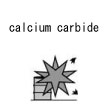| Case Name |
Explosion of acetylene gas accumulated in a drum can of calcium carbide on taking out |
| Pictograph |

|
| Date |
December 17, 1991 |
| Place |
Nagoya, Aichi, Japan |
| Location |
Chemical factory |
| Overview |
An explosion and fire occurred while calcium carbide was being taken out of a drum can, and an operator died. The cause is assumed that the operator opened the lid without following regulated procedures. Calcium carbide reacts with water and generates acetylene gas, which is combustible. If the regulated procedure is followed, even if acetylene gas is generated, operators could deal with it. This accident is a result of an insufficient work management and disregard for operation procedures. |
| Incident |
Acetylene gas in a drum can exploded at an acetylene gas-producing plant while calcium carbide was being taken out from the drum can. The top lid of the can was blown off, hit the operator's face, who fell down hitting the back of his head, and died. The acetylene gas generating reaction formula is shown in Fig2. |
| Processing |
Manufacture |
| Individual Process |
Charge and Feed |
| Chemical Equation |
Fig2.Chemical reaction formula
|
| Substance |
Calcium carbide |
| Type of Accident |
Explosion, fire |
| Sequence |
The operator had begun to take out calcium carbide from a can to produce acetylene gas.
He was going to open the drum lid using an electric drill.
Acetylene gas filled in the can exploded.
The top lid was blown off and hit his face.
He fell down.
He hit the back of his head and died since he was not wearing a helmet. |
| Cause |
The exploded gas was acetylene. It was generated in the can by the reaction of calcium carbide with water which entered the can. A crack of 16 mm in length was found at the lid of the can after the explosion. The crack was at the center of the lid, so water possibly entered the can through the crack, reacted with calcium carbide, and acetylene gas was generated. The operator probably did not make a prior visual inspection, so he could not predict that acetylene gas would be generated due to contaminated water. A combustible gas-air mixture might have been formed because nitrogen gas supplying was ignored. The direct cause is disregard of regulated procedures, and the damage spread because operators did not wear protective gear. |
| Response |
Injured people were taken to hospital. |
| Countermeasures |
Thorough visual inspection should be carried out.
Opening lid and handling drum cans should be mechanized.
Protective gear should be put on during work. |
| Knowledge Comment |
They should take safety measures suitable for the characteristics of substances when they are stored and handled such as calcium carbide, which can generate a combustible gas if mishandled. |
| Background |
The procedure for taking calcium carbide out of the drum can was predetermined as follows, 1) a operator drill a hole through the lid using a chisel, 2) he has to feed nitrogen gas, 3) under conditions of nitrogen gas flowing, he opens the lid with an electric drill. However, he did not follow the procedure. The operator might not have been educated about the reaction between water and calcium carbide and the danger of acetylene gas. Therefore, there might have been a lack of awareness of the danger.
Education and storage management will not be properly conducted unless the managers fully understand the reaction between water and calcium carbide. |
| Incidental Discussion |
The accident could have been prevented if operators had followed the procedures. However, it is necessary to educate on the danger in handling materials rather than simply directing operation procedures. |
| Reason for Adding to DB |
Example of explosion caused due to disregard of working procedure from insufficient education |
| Scenario |
| Primary Scenario
|
Poor Value Perception, Poor Safety Awareness, Inadequate Risk Recognition, Organizational Problems, Poor Management, Slackness of Management, Carelessness, Insufficient Understanding, Inufficient Understanding of the Risk, Malicious Act, Rule Violation, Safety Rule Violation, Usage, Transport/Storage, Bad Storage, Bad Event, Chemical Phenomenon, Abnormal Reaction, Secondary Damage, External Damage, Explosion, Bodily Harm, Death
|
|
| Sources |
Fire and Disaster Management Agency, Major accident case, Acetylene gas explosion accident, Accident cases of dangerous materials, pp.32, 338-339
|
| Number of Deaths |
1 |
| Notes |
Contamination reaction, combustible gas-air mixture. |
| Field |
Chemicals and Plants
|
| Author |
WADA, Yuji (National Institute of Advanced Industrial Science and Technology)
TAMURA, Masamitsu (Center for Risk Management and Safety Sciences, Yokohama National University)
|
|